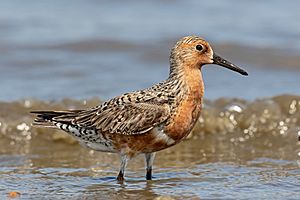B95 (bird) facts for kids

A Rufa Red Knot in the surf of the Delaware Bay in Cumberland County, NJ.
|
|
| Other name(s) | Moonbird |
|---|---|
| Species | Calidris canutus rufa |
| Sex | Male |
| Hatched | c. 1992 or earlier |
| Known for | his extreme longevity |
B95 (born around 1992), also known as Moonbird, is a famous red knot. He is known for being the oldest member of his species ever recorded.
B95 is a male bird from the Calidris canutus rufa group of red knots. Red knots are a type of shorebird in the sandpiper family. In February 1995, a scientist named Patricia González put a special band on his leg in Río Grande, Tierra del Fuego, Argentina. This band helped people track him. Since then, B95 has been seen many times. Patricia González saw him most recently in May 2014 in the Canadian Arctic. He has also been caught and checked at least three times. The last time was in 2007, when he was about 14 years old. Scientists found he was "as fit as a three-year-old" bird. It's not known how long red knots usually live, which makes B95's long life very special!
Contents
Why B95 is Called Moonbird
B95 is formally known by the label "B95" on the orange band on his leg. But he has a cool nickname: "Moonbird." He got this name because of his amazing yearly journeys. He flies along the Atlantic Flyway, traveling between Tierra del Fuego and the Canadian Arctic. The total distance he has flown in his life is more than the distance to the Moon! Every year, he flies about 20,000 miles (32,000 km).
Moonbird's Incredible Journey
When B95 flies north from Tierra del Fuego, he makes a very important stop. In the spring, he lands in Delaware Bay in the Northern Hemisphere. Here, he eats lots of horseshoe crab eggs. These eggs give him the energy he needs for the rest of his trip. After eating, he continues to his breeding grounds. These are on an island in the north of Hudson Bay.
Sadly, the number of red knots has gone down since the 1990s. This is partly because too many horseshoe crabs were caught in Delaware Bay for bait. To help the red knots, rules have been put in place to limit how many horseshoe crabs can be caught.
In November, B95 flies back to Tierra del Fuego for the Southern Hemisphere spring. On this journey, red knots eat mussels in the tidal flats there.
How B95 Helps Conservation
B95 has become a very important symbol. He helps people understand why we need to protect shorebirds.
Books and Statues About B95
A writer named Phillip Hoose worked as a conservationist for many years. He followed B95's movements for three years. He then wrote a book about him called Moonbird: A Year on the Wind with the Great Survivor B95. This book came out in 2012 and has won awards. It helped many people learn about B95 and the challenges faced by shorebirds.
There is even a statue of B95! You can find it in Mispillion Harbor on Delaware Bay. The city of Río Grande in Tierra del Fuego has even called B95 their "natural ambassador." This shows how much he means to people who care about nature.

